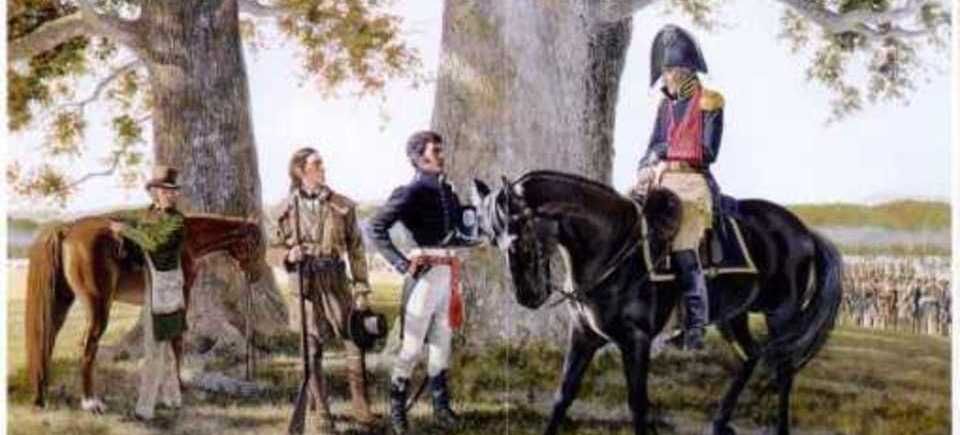Camp Blount - Crossroads to Destiny
In 1811 the Shawnee chief Tecumseh conducted a mission to the Creek Nation in Alabama. He urged the Creeks to throw off the white culture that many had adopted and return to the ancient traditions of their people. Many Creeks heeded Tecumseh's call, while others resisted. A civil war broke out among the Creek Nation in 1812, almost the same time the war between the United States and Great Britain began. The traditionalist faction, known as the Red Sticks, occasionally carried their war to the white settlers living on the frontiers, including forays into Tennessee. In August, 1813, Red Sticks attacked and captured Fort Mims in Southern Alabama, slaughtering 250 men, women and children. This massacre galvanized the Southern States, and Tennessee sent an expedition of Tennessee Militia under the command of Major General Andrew Jackson to destroy the Red Stick menace.
In early October, the Tennessee troops rendezvoused at Fayetteville, encamped near four ancient oak trees. The camp was named Camp Blount after the governor who called the troops into service. On the 7th of October Jackson arrived at Camp Blount, his arm in a sling recovering from a wound received in a fight in Nashville several weeks before.
Tennessee mounted troops under the command of General John Coffee moved south into Alabama. A scouting patrol by private David Crockett of the 2nd Regiment Volunteer Mounted Riflemen indicated that a large number of Creek warriors were headed toward Coffee's position. Crockett's report caused Jackson to remove the balance of the Tennessee army from Fayetteville to Huntsville, Alabama, from which point he moved south into the Creek Nation to carry the war to the Red Sticks. A series of battles were fought culminating in the Battle of Horseshoe Bend in March, 1814.
The Fayetteville physician, Dr. Charles McKinney, with his needed medical skills, accompanied Jackson's army. Horseshoe Bend saw slaughter on a large scale. Nearly 900 Creek warriors died, breaking the back of the Red Stick movement. Casualties among the Tennessee's numbered 47 dead and 159 wounded, with another 23 dead and 47 wounded among Tennessee's Cherokee and Creek allies. One of the wounded tended by Dr. McKinney was a 21 year old Ensign Sam Houston of the 39th U.S. infantry Regiment. Houston's wounds, an arrow to thigh and two muskets balls in the shoulder, were very serious and believed by the doctor to be fatal.
Dr. McKinney returned to build a successful medical career in Fayetteville, where his descendants still reside and still practice medicine today. General Jackson went on to defeat the British at New Orleans, and in 1828 was elected the 7th President of the United States. Ensign Sam Houston recovered from his wounds, was elected the 7th governor of Tennessee in 1827, and in 1836 became President of the Republic of Texas. Crockett would pass through Camp Blount once again, this time as a Sergeant in Major Russell's Battalion of Tennessee Mounted Gunmen, to assist Jackson in the taking of Mobile prior to his defense of New Orleans. Crockett was later elected to the State legislature and to the U.S. Congress. He would cross paths again with both Jackson and Houston, becoming the bane of Jackson's presidency, and later helping make Houston's presidency possible and securing Texan independence by giving his life at the Alamo.
In August, 1813 the Creek civil war expanded beyond the borders of the Creek Nation, when the traditionalists faction, known as the Red Sticks, captured Fort Mims, (in today's Alabama), and slaughtered about 250 inhabitants without regard for age or gender. As a result, the government of Tennessee called for 3,500 volunteers to muster under the command of Major General Andrew Jackson.
The road from Nashville to the Creek Nation led through the town of Fayetteville, just north of the Alabama border. In September 1813, just east of Fayetteville, on the waters of the Elk River, a mustering site for the gathering militia army was chosen. Standing over the mustering grounds, like ancient sentinels, were four grand white oak trees, each over two hundred years of age.
The mustering ground was christened Camp Blount, in honor of Willie Blount, governor of the Tennessee at the time. Militiamen from around Middle Tennessee gathered here, and from Camp Blount marched into the Creek Nation, to break the back of the Red Stick movement at the Battle of Horseshoe Bend in March 1814.
Camp Blount would see service later in 1814 as a militia mustering ground for troops going to assist General Jackson in operations around Mobile and the defense of New Orleans. Three years later Tennessee soldiers would again rendezvous here, this time to assist Jackson in a campaign against the Seminoles in Florida.
Andrew Jackson was elected president of the United States in 1828, and re-elected in 1832. In 1836, the last year of Jackson's presidency, Tennessee troops would once again muster near Fayetteville, to follow General William Lauderdale to central Florida in the final war against the Seminole Nation. During the War Between the States both the Confederate and Union armies would use the land around Camp Blount as a camping ground.
All during that time period, from 1813 to 1865, the soldiers of Tennessee camping and drilling on these grounds did so under the silent watch of the four camping ancient oaks. Those trees would continue to mark this land as the end of the 20th century neared. For four hundred years they stood, but they could not stand forever, and in recent years two of them fell to the march of commercial development.
In 1998 students of the Advanced American history class at Lincoln County High School researched the history of Camp Blount, and had a State historical marker erected near the two remaining oaks by H. David Wright was commissioned in 1998 and completed the painting in 1999. Set in a historical context, with troops mustering in Camp Blount in the background, the painting portrays Fayetteville physician, Dr. Charles McKinney, who ministered to the Tennessee troops during the Creek war, along with three Tennessee heroes associated with that war: General Andrew Jackson, Ensign Sam Houston, and Private David Crockett.
Proceeds from the sale of the limited edition prints will be used to fund history scholarships for students at Lincoln County High School.




